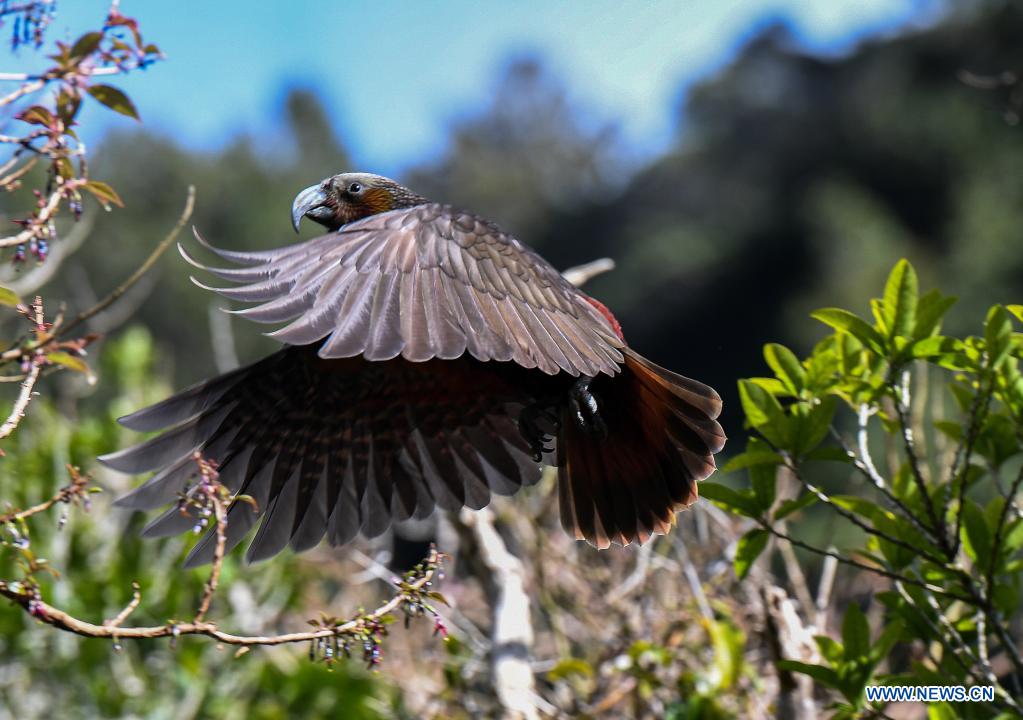
File photo taken on Sept. 9, 2020 shows a kaka, a native bird to New Zealand at Zealandia Eco-sanctuary in Wellington, New Zealand. In the 1990s, kaka, a native bird to New Zealand, was considered nearly extinct in the main islands of the country. However, Zealandia Eco-sanctuary witnessed more than 1,000 kaka chicks tagged in the past 20 years due to conservation efforts of a re-introduction program. (Xinhua/Guo Lei)
WELLINGTON, May 20 (Xinhua) -- "I live about 2 km from Zealandia (Wellington) and it is a rare day when I don't see kaka or hear their tell-tale screech," Ian Archer, a bird observer, told Xinhua.
In the 1990s, kaka, a native bird to New Zealand, was considered nearly extinct in the main islands of the country. However, Zealandia Eco-sanctuary witnessed more than 1,000 kaka chicks tagged in the past 20 years due to conservation efforts of a re-introduction program.
"Actually, we don't know how many kaka we have in the Wellington region now," Archer said with joy in his eyes. He is a professional bird observer to Zealandia, and once served as an environmental volunteer in the Eco-sanctuary for 14 years.
Zealandia was a dam for locals' water supply near the city center of Wellington before being deserted due to potential earthquake risk in 1997. A man named Jim Lynch realised that if the deserted dam located in the valley could be surrounded by a pest-proof fence, then endangered species could be reintroduced safely.
By 1999, an 8.6-km-long, 2.2-meter-tall fence was designed and erected around the dam region, pest species were removed in the following months and re-introduction of native species started by the end of 2000.
In 2002, 14 captive-bred kaka were re-introduced to Zealandia. The lack of mature native trees in Zealandia means the birds originally were short of full range of natural food, nor nesting places, usually like natural holes in big trees. Working staffs of Zealandia then provide plenty of nest boxes made from large plastic pipes and lined with wood for the kaka to chew on. Additionally, two types of supplemental food became birds' regular "desserts" in the sanctuary. One is sugar water and the other is a sort of mixture of honeyeater food.
Plenty of places to nest, supplementary food to feed the young and safety from predators are crucial measures for the extinctive birds to re-establish in the wild.
"Three to six eggs are usually laid with incubation usually starting after the 3rd egg being laid. Chicks that hatch several days later than their siblings can be significantly smaller than the older chicks for the first few weeks," Archer said.
"In the wild with limited food, this often means that smaller chicks do not survive. At Zealandia where supplementary food is readily available, this allows most chicks to survive."
To date, kaka with band have been identified up to 200 km away from Wellington, which means the birds have successfully nested outside the sanctuary and no longer need human support.
Zealandia is not only the Eco-sanctuary for kaka, but also shelters of hihi, takahe, kiwi, saddleback, all the extinctive native birds to New Zealand and home for more than 200 tuatara, a sort of reptile from the Dinosaur's age. The dam, once the surplus of the city, now is an asylum to the endangered birds, animals and floras. Enditem